Garden Journal - Cutting Back the Pond Irises
One of the jobs I should do every winter is pay attention to the pond and cut back the pond irises.
But the last couple of winters I haven't done it aggressively enough. The reality is that these are a plant which probably works best if you've got a large ornamental lake. But I don't live in a stately home (far from it !) and we've just got a very small pond.
As you can see from the photo below, the irises have taken over just under half of the pond.


The foliage has died back now, which means it's the right time to deal with it.
This photo is an older one, from back in the summer when they were in full bloom. Very pretty, and very bee friendly, but just too many irises for one small pond !

The irises are a species known as yellow flag iris, or iris pseudacorus.
In America it's actually defined as an invasive species which should be got rid of if you spot it. But it's trapped in our pond and not invading anywhere right now; it spreads by using seed pods that float off down rivers. Our pond doesn't have a river.
I didn't take any photos of us cutting the irises back. It was a muddy, wet, messy job, and I try not to get too much mud on my mobile phone ! The original plan was to lift the whole mass out and cut them back on dry land before putting the remainder back in the pond. Total fail; it was far too heavy for two of us to lift. So we got to work with an axe and heavy duty loppers instead.
The photo below shows how much we cut out. The plant forms a solid mass of roots and trapped mud, which is why it can overwhelm a pond of lake where it's allowed to grow out of control. It just seems to make new land !
We put the bits we'd removed into a large plastic tray so that it can drain for a while. It'll make the bits we've removed lighter when we put them in the garden waste bin, and the water that drains off can be tipped back into the pond along with all the nice nutrients it contains.

The photos below are the "after" images. The water was all stirred up and muddy, and it's likely that I might reduce the irises a whole load more. But just a little bit at a time; after doing this lot, my back and hands was wrecked for the day. Thank goodness for Voltarol gel !


I took these photos a few hours later, once the mud had subsided. It's good to see nice clear water again. We'd removed so much matted roots and mud that it dropped the water level in the pond by at least two inches !


I have a feeling that if they're like most plants in our garden, after being cut back hard they'll just return next year even more vigorous than before....
All photos by me
Man, that's a lot of work. And invasive or not, they sure are pretty!
Yeah, I really like them and they're very bee-friendly. The roots are mildly toxic if any wildlife eats them, and it really does get out of control very fast, but on the upside it provides lots of cover for the frogs to hide in up to the point where it turns into dry land.
!BBH
@oblivioncubed! @alonicus likes your content! so I just sent 1 BBH to your account on behalf of @alonicus. (2/20)
(html comment removed: )
)
This is seriously hard work haha that space will be spectacular when you finish reorganizing it 👌
Thank you ! It's the most neglected end of the garden, and winter is a good time to tidy it up. I'll probably get rid of the euphorbia bush to reduce the amount of shade in the area 😀
!BBH
!PIZZA
@elbuhito! @alonicus likes your content! so I just sent 1 BBH to your account on behalf of @alonicus. (1/20)
(html comment removed: )
)
$PIZZA slices delivered:
@alonicus(1/5) tipped @elbuhito
Hard work but rewarding too
We support gardening, homesteading, cannabis growers, permaculture and other garden related content. Delegations to the curation account, @gardenhive, are welcome! Keep an eye out for our weekly writing prompts and our monthly #gardenjournal challenge on the 1st of each month.